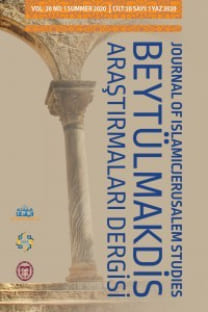Artuklular ve Eyyubiler Döneminde Kudüs'te İlmi Hayt: Karşılaştırma ve Değerlendirme
The Scholarly Life in Bayt al-Maqdis During the era of the Artuqids and the Ayyubids: Comparison and Evaluation
Scholarly life, Artuq Bey, Schools, Scholars, Bayt al-Maqdis, Salah al-Din,
___
- Abul-Fida, Imad al-Din (n.d.). al-Mukhtasar fi Akhbar al-Bashar. Cairo: al-Matbah al-Husayniyah al-Misriyah.
- Abu-Shamah, A. (1418AH). Kitab al-Rawdatayn fi Akhbar al-Dawlatayn al-Nuriyah wal-Salahiyah. Beirut: Mu’asast al-Risalah.
- Ahmad, Ruwaida (2015). Al-Madrasah al-Salahiyah fi al-Quds. Master Dissertation, An-Najah University, Nablus.
- Al-Asfahani, Imad al-Din (1425AH). Hurub Salah al-Din wa-Fath Bayt al-Maqdis: Al-Fath al-Qusi fi al-Fath al-Qudsi. Beirut: Dar al-Manar.
- Al-Dhahabi, M. A. O. (2003). Tarikh al-Islam wa-Wafayat al-Mashahir wal-Alam. Beirut: Dar al-Gharb al-Islami.
- Al-Hanbali al-Ulaymi, Mujir al-Din (1999). Al-Uns al-Jalil bi-Tarikh al-Quds wal-Khali. Hebron: Maktabat Dandis.
- Al-Husayni, Muhammad (n.d.). Zuyul al-Ibar lil-Zahabi. Kuwait: Matbat Hukumat al-Kuwait.
- Al-Maqrizi, Taqi al-Din (n.d.). Itiaz al-Hunafa bi-Akhbar al-A’imah al-Fatimiyin al-Khulafa. Lajnat Ihya’ al-Turath al-Islami.
- Al-Nasafi, Najm al-Din (1378AH). Al-Qand fi Zikr Ulama’ Samarqand. Mu’asast al-Tiba’ah.
- Al-Qafti, Jamal al-Din (1406AH). Inba’ al-Ruwah ala Anbah al-Nuhat. Cairo: Mu’asast al-Kutub al-Thaqafiyah.
- Al-Salafi, Ahmad (n.d.). Majam al-Safar. Makkah: al-Maktabah al-Tijariyah.
- Al-Samani, AbdulKarim (1382AH). Al-Ansab. Haydarabad: Majlis Dairat al-Marif al-Uthmaniyah.
- Al-Subki, Taj al-Din (1413AH). Tabaqat al-Shafiyah al-Kubra. Hajir lil-Tiba’ah wal-Nashir.
- Al-Zubaidi, M. (n.d.). Taj al-Arous min Jawahir al-Qamous. Dar al-Hidayah.
- Ibn al-Adim, Umar (n.d.). Bughyat al-Talab fi Tarikh Halab. Dar al-Fikr.
- Ibn al-Arabi, Muhammad (1406AH). Qanun al-Ta’wil. Jeddah: Dar al-Qiblah lil-Thaqafah al-Islamiyah.
- Ibn al-Arabi, Muhammad (1413AH). Al-Nasikh wal-Mansukh fi al-Quran al-Karim. Maktabat al-Thaqafah al-Diniyah.
- Ibn al-Arabi, Muhammad (1424AH). Ahkam al-Quran. Beirut: Dar al-Kutub al-Ilmiyah.
- Ibn al-Arabi, Muhammad (1992AH). Al-Qabas fi Sharh Muwata’ Malik ibn Anas. Beirut: Dar al-Gharb al-Islami.
- Ibn al-Arabi, Muhammad (n.d.). al-Awasim min al-Qawasim. Egypt: Maktabat Dar al-Turath.
- Ibn al-Athir, Izz al-Din (1385AH). Al-Kamil fi al-Tarikh. Beirut: Dar Sadir.
- Ibn al-Jawzi, Y. (1434AH). Miraat al-Zamaan fi Tawarikh al-Ayan. Damascus: Dar al-Risalah al-Almiyah.
- Ibn al-Qalanisi, Hamza (1983). Tarikh Dimashq. Damascus: Dar Hassan lil-Tiba’ah wal-Nashir.
- Ibn al-Wardi, Umar ibn Muzaffar (1417AH). Tarikh Ibn al-Wardi. Beirut: Dar al-Kutub al-Ilmiyah.
- Ibn Asakir, Ali (n.d.) Tarikh Dimashq. Damascus: Dar al-Fikr.
- Ibn Fahd al-Maki, M. (1347AH). Lahz al-Alhaz bi-Zayl Tabaqat al-Hufaz lil-Zahabi. Damascus.
- Ibn Kathir, Ismail (1413AH). Tabaqat al-Shafiyin. Maktabat al-Thaqafah al-Diniyah.
- Ibn Kathir, Ismail (1418AH). Al-Bidayah wal-Nihayah. Dar Hajir.
- Ibn Khair, Muhammad (1419AH). Fahrasat Ibn Khair al-Ishbili. Beirut: Dar al-Kutub al-Ilmiyah.
- Ibn Khalikan, A. M. I. (1994). Wafayat al-Ayan wa-Anba’ Abna’ al-Zaman. Beirut: Dar Sadir.
- Ibn Qadi Shuhbah, Abubakir (n.d.). Manaqib al-Imam al-Shafi.
- Ibn Shadad, Izz al-Din (1978). Al-A‘laq al-Khatirah fi Zikr Muluk al-Sham wal-Jazeera. Damascus: al-Ma‘had al-Faransi lil-Dirasat al-Arabiyah.
- Ibn Tagribardi, Y. (n.d.). Al-Nujum al-Zahirah fi Muluk Misr wal-Qahira. Cairo: Dar al-Kutub.
- Ibn Wasil, M. S. (1377AH). Mufarij al-Kurub fi Akhbar bani Ayub. Ed. Jamal al-Din al-Shayal. Cairo: al-Kutub wal-Wathaiq al-Qawmiyah.
- Kadad, Mustafa. (2020). al-Istitan al-Salibi li-Bayt al-Maqdis wa-Tahjir al-Maqdissyin. Journal of Islamicjerusalem Studies, vol.20/ 3, pp. 369-388.
- Kurd Ali, M. (1403AH). Khutat al-Sham. Damascus: Maktabat al-Nuri.
- Lee Strange (1985). Buldan al-Khilafah al-Sharqiyah. Beirut: Mu’asast al-Risalah.
- ISSN: 1367-1936
- Yayın Aralığı: Yılda 2 Sayı
- Başlangıç: 1997
- Yayıncı: Beytülmakdis Çalışmaları Vakfı
Hadislerde Kudüs ve Mescid-i Aksa
Kadı Fadıl Abdurrahim Al-Bisani'in Kudüs'ü özgürleştirmeye yönelik entelektüel çabaları
Beytülmakdis’in Özgürleştirilmesinde İsimsiz Kahramanları
Türkiye’de İlk Tıp Fakültesi’ni Mardin’de Artuklular Kurdu
Artuklular ve Eyyubiler Döneminde Kudüs'te İlmi Hayt: Karşılaştırma ve Değerlendirme
Müfessirlerin “Mescid-i Aksâ” Hakkındaki Görüşleri: İsrâ Suresi 1. Ayetin Tefsiri Bağlamında
Haçlıların Kudüs'e Yerleşmesi Ve Kudüslülerin Yerlerinden Edilmesi
Beytülmakdis’in Selahaddin Eyyûbî Tarafından Fethinin Tefsirlerdeki Yansımaları
Artuklular Döneminde Ortadoğu'daki Dengeler Arasındaki Mücadelede Kudüs'ün önemi
